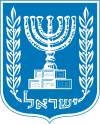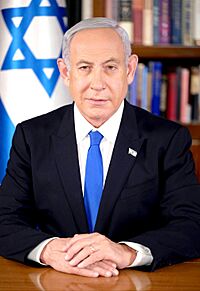Prime Minister of Israel facts for kids
Quick facts for kids Prime Minister of Israel |
|
|---|---|

Prime Ministerial Standard
|
|

|
|
| Prime Minister's Office | |
| Style | His Excellency |
| Residence | Beit Aghion |
| Nominator | President |
| Appointer | Knesset |
| Term length | Four years, renewable indefinitely |
| Inaugural holder | David Ben-Gurion |
| Formation | 14 May 1948 |
| Deputy | Alternate Prime Minister |
| Salary | US$170,000 annually |
The prime minister of Israel (Hebrew: רֹאשׁ הַמֶּמְשָׁלָה, romanized: Rosh HaMemshala, lit. 'Head of the Government') is the main leader of the State of Israel. They are in charge of the government and make important decisions for the country.
Israel is a parliamentary republic. This means it has a president who is the head of state, but their role is mostly ceremonial, like a symbol for the country. The prime minister, however, holds the real power to run the government. The prime minister's official home, called Beit Aghion, is in Jerusalem. The current prime minister is Benjamin Netanyahu from the Likud party. He is the ninth person to hold this important job.
| Top - 0-9 A B C D E F G H I J K L M N O P Q R S T U V W X Y Z |
How a Prime Minister is Chosen
After an election, the President talks to leaders of different political parties. They ask who the parties support to be the next prime minister. The President then chooses a member of the Knesset (Israel's parliament) to try and form a government.
This chosen person has 28 days to create a government that has the support of most members in the Knesset. Once they have enough support, they present their plans to the Knesset. The Knesset then votes to approve the new government. If approved, the person becomes prime minister.
Usually, the prime minister is the leader of the largest party in the group of parties that form the government. It's very rare for one party to win enough seats to govern alone in Israel. Because of this, Israeli governments are almost always made up of two or more parties working together.
The prime minister in Israel has a lot of power. This is because a special law, called "Basic Law: The Government," clearly states that the prime minister leads the government and has executive power. This means they are truly in charge of making decisions and carrying them out.
History of the Prime Minister's Role
The job of prime minister started on May 14, 1948. This was the day Israel declared its independence. A temporary government was created, and David Ben-Gurion became Israel's first prime minister. He was the leader of the Jewish Agency.
The position became permanent in March 1949, when the first official government was formed. Ben-Gurion served until late 1953, when he decided to live in a Kibbutz called Sde Boker. Moshe Sharett took over, but Ben-Gurion returned less than two years later. He resigned again in 1963.
Levi Eshkol then became prime minister. He was the first prime minister to lead the country under the name of two parties working together. This happened when his party, Mapai, joined with another party to form the Alignment in 1965.
On February 26, 1969, Eshkol became the first prime minister to die while in office. Yigal Allon temporarily took his place for a short time. Then, Golda Meir was asked to return to politics and became prime minister in March 1969. She was Israel's first woman prime minister and one of the first in the world.
Meir resigned in 1974 after a report about the Yom Kippur War was published. Yitzhak Rabin then became prime minister. He also resigned later after some challenges. His wife, Leah, was found to have an overseas bank account, which was against the law in Israel at the time.
Menachem Begin became the first prime minister from a right-wing party when his Likud party won the 1977 elections. He resigned in 1983 due to health reasons, and Yitzhak Shamir took over.
After the 1984 elections, no single party could form a government. So, a special "national unity government" was created. In this arrangement, Shimon Peres served as prime minister for the first two years, and then Shamir took over for the rest of the term.
Rabin became prime minister for a second time in 1992. Sadly, he was assassinated on November 4, 1995. Peres then took over as prime minister.
Direct Election Period
Between 1996 and 2001, Israel tried a different way of choosing its prime minister. People voted directly for the prime minister, separate from voting for the Knesset members. This system was tried because it was so hard for one party to win a majority in the Knesset.
In 1996, Benjamin Netanyahu won the first direct election for prime minister. However, his party didn't win the most seats in the Knesset. This meant he still needed the support of other parties to form a government.
This system didn't work as well as hoped. In 1999, new elections were called. Ehud Barak won the prime minister election. But his party also won very few seats in the Knesset, so he had to form a government with many smaller parties.
In 2001, Barak resigned. Ariel Sharon of Likud won the next direct prime ministerial election. But again, his party had few seats in the Knesset, so he had to form a broad government. After this, Israel decided to go back to the old system where the prime minister is chosen by the Knesset.
Recent Prime Ministers
The 2003 elections went back to the old system. Likud won many seats, and Ariel Sharon became prime minister. Later, Sharon left his party to form a new one called Kadima. He became the first prime minister who was not from the Labour or Likud parties.
In January 2006, Sharon had a stroke. Ehud Olmert became the acting prime minister. After the 2006 elections, Olmert officially became prime minister.
In 2008, Olmert resigned. His successor, Tzipi Livni, could not form a government. In the 2009 election, Benjamin Netanyahu was asked to form a government, starting his second time as prime minister.
Netanyahu continued to serve as prime minister after the 2013 and 2015 elections. Israel then went through a period of political challenges from 2019 to 2022, with several elections.
In 2021, Naftali Bennett became prime minister. He was followed by his coalition partner, Yair Lapid, in July 2022. In December 2022, Benjamin Netanyahu returned to the prime minister's office, starting his third period as prime minister.
What Happens if a Prime Minister Can't Serve?
If a prime minister dies while in office, the government chooses an interim (temporary) prime minister. This person runs the government until a new one is formed. For example, Yigal Allon became interim prime minister after Levi Eshkol died. Shimon Peres also served as interim prime minister after Yitzhak Rabin was assassinated.
If a prime minister is temporarily unable to do their job (like when Ariel Sharon had a stroke), an acting prime minister takes over. This can last for up to 100 days. If the prime minister is declared permanently unable to serve, or if 100 days pass, the President starts the process of forming a new government. In the meantime, the acting prime minister or another minister is appointed as an interim prime minister.
Acting, Vice, and Deputy Prime Ministers
Besides the acting prime minister, there can also be vice prime ministers and deputy prime ministers. These roles support the prime minister.
Interim Prime Minister
An interim prime minister is chosen by the government if the prime minister dies, resigns, is permanently unable to serve, or is removed due due to a criminal conviction.
There's a difference between an "acting prime minister" and an "interim prime minister." An acting prime minister fills in temporarily while the prime minister is still in office but unable to work. An interim prime minister takes over when the prime minister's time in office has ended for good.
Both the interim and acting prime ministers have almost the same powers as a regular prime minister. However, they cannot dissolve the Knesset (parliament).
Interim Government
An 'interim government' is the same government, but its legal status changes. This happens after the prime minister dies, resigns, is permanently unable to serve, or is removed due to a criminal conviction. It also happens if the prime minister asks to dissolve the Knesset, or if the government loses a vote of no confidence. An interim government also serves after an election and before a new government is officially formed.
Prime Minister's Residence
Since 1974, the official home of the prime minister has been Beit Aghion. It is located in Rehavia, a neighborhood in Jerusalem.
List of Prime Ministers of Israel
- Term of office in years
See also
 In Spanish: Primer ministro de Israel para niños
In Spanish: Primer ministro de Israel para niños
- Beit Aghion
- Cabinet of Israel
- Prime Minister's Office (Israel)


